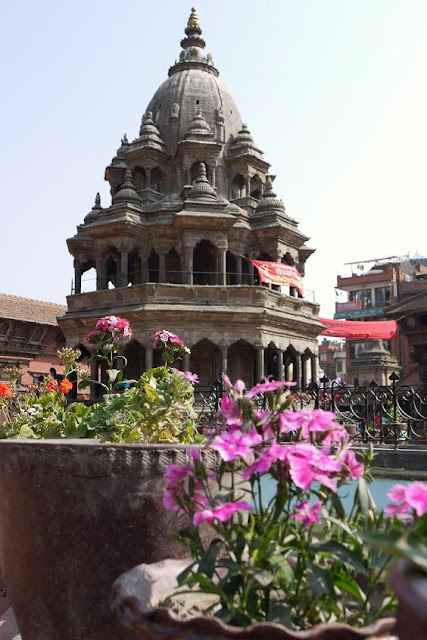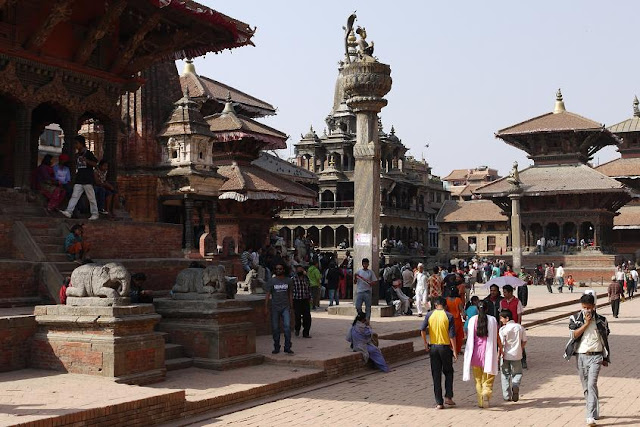 Since we'd come down from the mountains a few days earlier than we'd expected, we were happy to take advantage of the extra time to explore the greater Kathmandu Valley. We hired a taxi for the day to drive us around. Our first stop was Swayambhunath, a Buddhist holy place also known as the Monkey Temple after the monkeys that guard the temple, and feast on the offerings of food that are brought for the gods.
Since we'd come down from the mountains a few days earlier than we'd expected, we were happy to take advantage of the extra time to explore the greater Kathmandu Valley. We hired a taxi for the day to drive us around. Our first stop was Swayambhunath, a Buddhist holy place also known as the Monkey Temple after the monkeys that guard the temple, and feast on the offerings of food that are brought for the gods. Swayambhunath is perched atop a steep hill. Local legend says this hill rose spontaneously out of the lake that used to cover the Kathmandu Valley (geologists agree that the area used to be a lake). Around 460 A.D. construction of a temple began here. By the 1200’s the temple had become an important Buddhist center. After passing through the gate at the bottom we looked up the impossibly long flight of dusty stairs and were glad we’d made this our first stop, before the heat of the afternoon sun. A cat, undeterred by the roaming monkeys, leaped up the stairs easily ahead of us, then paused to eye us as we lumbered to the top, sweaty and out of breath.
The hill is topped by a huge Buddhist stupa, which is an imposing white dome topped by the face of Buddha wearing a tall spire of a hat. The question-mark shaped nose that is depicted in Nepal on Buddha’s face is the Nepali symbol for ek (one), and is a symbol of the unity of all life. The base of the stupa is encircled by prayer wheels, on each one the Buddhist chant of Om Mani Padme Hum is written in Nepali. All over Nepal, over and over again (including on the top of this hill), we heard the singing version of this chant pumping out of battery-operated boom box speakers. I’m not certain, but it sure seems like Buddhism has only one song.
Behind the stupa, a huge crowd was gathered, some waiting in line to pay their respects at the shrine also sitting atop the hill that is dedicated to the Hindu goddess of smallpox, Hariti, who also doubles as a Buddhist deity. For some reason, people also pray to Hariti for success on exams, so there were many families in line with school-age children. Other people milled about near the open fires that were burning on the ground, or lighting the small butter votives as offering. Monkeys hopped down from their perches on top of the stupa or temple to snatch bits of food, then hopped back up, clambering over the prayer wheels and stone carvings of deities.
Our next stop was an even larger Buddhist stupa called Bodhnath. Our guidebook says it was first built at this spot near 600 A.D., after the Nepali king Songtsen Gampo was converted to Buddhism by his two wives; one the Nepali princess Bhrikuti, and the other a Chinese woman named Wencheng Konjo. The big mounds of stupas were originally built to bury holy objects or people, and some believe that a piece of bone once belonging to the Buddha is interred at Bodhnath.
Our last destination of the day was the neighboring town of Patan. Only 20 minutes away from Kathmandu by taxi, Patan was once a separate kingdom, and has its own Durbar Square (Palace Square). Patan’s Durbar Square is intensely atmospheric, which much more architectural diversity than Kathmandu’s, and it’s more peaceful too, a good place to grab a shady spot and people watch.
A portion of the former palace was restored in the 1990s by an Austrian non-profit working with the Nepal government, and it houses a beautiful museum. I especially enjoyed the old black and white photographs and etchings from the early 1700s and 1800s that depicted Patan when it was first “discovered” by westerners. Eerily, the square today looks exactly as it did three hundred years ago; crumbling but still beautiful. Even the style of Nepali dress favored by the old-timers hasn’t changed.
Mohit bought a dis- appointingly freezer- burned cup of ice cream, and while we sat in the shade I watched two little kids run up to a nut and popcorn vendor waving dirty rupee notes. They each bought a cone of toasted nuts and then strolled away happily, talking to each other a mile a minute as they walked right down the middle of the street. They couldn’t have been more than five years old, and I winced as motorbikes swerved to avoid them.
The next morning, our flight was delayed three times by the heavy brown smog that had settled in the valley; when we finally took off we both strained to see the mountains in the distance but the air pollution obscured everything more than fifty feet away. But we finally spied dozens of snow-capped peaks framed by dazzling blue sky to the north after our plane rose above the cloud cover. I hope that Nepal is able to sort out its political and economic challenges without compromising its stunning natural beauty and rich cultural history.






























No comments:
Post a Comment